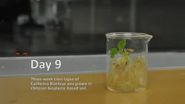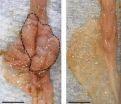(Press-News.org) Researchers at Harvard's Wyss Institute have developed a method to carry out large-scale manufacturing of everyday objects – from cell phones to food containers and toys – using a fully degradable bioplastic isolated from shrimp shells. The objects exhibit many of the same properties as those created with synthetic plastics, but without the environmental threat. It also trumps most bioplastics on the market today in posing absolutely no threat to trees or competition with the food supply. The advance was reported online last week in Macromolecular Materials & Engineering.
Most bioplastics are made from cellulose, a plant-based polysaccharide material. The Wyss Institute team developed its bioplastic from chitosan, a form of chitin, which is a powerful player in the world of natural polymers and the second most abundant organic material on Earth. Chitin is a long-chain polysaccharide that is responsible for the hardy shells of shrimps and other crustaceans, armor-like insect cuticles, tough fungal cells walls – and flexible butterfly wings.
The majority of available chitin in the world comes from discarded shrimp shells, and is either thrown away or used in fertilizers, cosmetics, or dietary supplements, for example. However, material engineers have not been able to fabricate complex three-dimensional (3D) shapes using chitin-based materials – until now.
The Wyss Institute team, led by Postdoctoral Fellow Javier Fernandez, Ph.D., and Founding Director Don Ingber, M.D., Ph.D., developed a new way to process the material so that it can be used to fabricate large, 3D objects with complex shapes using traditional casting or injection molding manufacturing techniques. What's more, their chitosan bioplastic breaks down when returned to the environment within about two weeks, and it releases rich nutrients that efficiently support plant growth.
"There is an urgent need in many industries for sustainable materials that can be mass produced," Ingber said. Ingber is also the Judah Folkman Professor of Vascular Biology at Boston Children's Hospital and Harvard Medical School, and Professor of Bioengineering at the Harvard School of Engineering and Applied Sciences. "Our scalable manufacturing method shows that chitosan, which is readily available and inexpensive, can serve as a viable bioplastic that could potentially be used instead of conventional plastics for numerous industrial applications."
The advance reflects the next iteration of a material called Shrilk that replicated the appearance and unique material properties of living insect cuticle, which the same team unveiled about two years ago in Advanced Materials. They called it Shrilk because it was composed of chitin from shrimp shells plus a protein from silk.
VIDEO:
The research team grew a California Blackeye pea plant in soil enriched with its chitosan bioplastic over a three-week period -- demonstrating the material's potential to encourage plant growth once...
Click here for more information.
In this study, the team used the shrimp shells but ditched the silk in their quest to create an even cheaper, easier-to-make chitin-based bioplastic primed for wide-spread manufacturing.
It turns out the small stuff really mattered, Fernandez said. After subjecting chitosan to a battery of tests, he learned that the molecular geometry of chitosan is very sensitive to the method used to formulate it. The goal, therefore, was to fabricate the chitosan in a way that preserves the integrity of its natural molecular structure, thus maintaining its strong mechanical properties.
"Depending on the fabrication method, you either get a chitosan material that is brittle and opaque, and therefore not usable, or tough and transparent, which is what we were after," said Fernandez, who recently won the Bayer "Early Excellence in Science" Award for his achievements in materials science and engineering.
After fully characterizing in detail how factors like temperature and concentration affect the mechanical properties of chitosan on a molecular level, Fernandez and Ingber honed in on a method that produced a pliable liquid crystal material that was just right for use in large-scale manufacturing methods, such as casting and injection molding.
Significantly, they also found a way to combat the problem of shrinkage whereby the chitosan polymer fails to maintain its original shape after the injection molding process. Adding wood flour, a waste product from wood processing, did the trick.
"You can make virtually any 3D form with impressive precision from this type of chitosan," said Fernandez, who molded a series of chess pieces to illustrate the point. The material can also be modified for use in water and also easily dyed by changing the acidity of the chitosan solution. And the dyes can be collected again and reused when the material is recycled.
This advance validates the potential of using bioinspired plastics for applications that require large-scale manufacturing, Fernandez explained. The next challenge is for the team to continue to refine their chitosan fabrication methods so that they can take them out of the laboratory, and move them into a commercial manufacturing facility with an industrial partner.
INFORMATION:
IMAGES AVAILABLE
About the Wyss Institute for Biologically Inspired Engineering at Harvard University
The Wyss Institute for Biologically Inspired Engineering at Harvard University uses Nature's design principles to develop bioinspired materials and devices that will transform medicine and create a more sustainable world. Working as an alliance among all of Harvard's Schools, and in partnership with Beth Israel Deaconess Medical Center, Brigham and Women's Hospital, Boston Children's Hospital, Dana Farber Cancer Institute, Massachusetts General Hospital, the University of Massachusetts Medical School, Spaulding Rehabilitation Hospital, Boston University, Tufts University, and Charité - Universitätsmedizin Berlin, the Institute crosses disciplinary and institutional barriers to engage in high-risk research that leads to transformative technological breakthroughs. By emulating Nature's principles for self-organizing and self-regulating, Wyss researchers are developing innovative new engineering solutions for healthcare, energy, architecture, robotics, and manufacturing. These technologies are translated into commercial products and therapies through collaborations with clinical investigators, corporate alliances, and new start-ups.
Manufacturing a solution to planet-clogging plastics
Research team paves way to scale up manufacturing of large objects using a fully compostable bioplastic made from shrimp shells
2014-03-04
ELSE PRESS RELEASES FROM THIS DATE:
Pediatric surgeons develop standards for children's surgical care in the United States
2014-03-04
Chicago (March 3, 2014): The American College of Surgeons (ACS) has published new comprehensive guidelines that define the resources the nation's surgical facilities need to perform operations effectively and safely in infants and children. The standards—published in the March issue of the Journal of the American College of Surgeons—also have the approval of the American Pediatric Surgical Association and the Society of Pediatric Anesthesia. Representatives of these organizations as well as invited leaders in other pediatric medical specialties, known as the Task Force ...
HPV vaccine provides significant protection against cervical abnormalities
2014-03-04
The HPV vaccine offers significant protection against cervical abnormalities in young women, suggests a paper published on bmj.com today.
The human papillomavirus (HPV) can cause warts, with some strains causing cervical cancer.
Australia was the first country to implement a publicly funded national vaccination programme in April 2007 and a 'catch-up' programme that ran until December 2009.
Studies have shown that the two HPV vaccines used to vaccinate young women prevent cervical lesions associated with HPV types including vulval and vaginal lesions and genital ...
Report describes Central Hardwoods forest vulnerabilities, climate change impacts
2014-03-04
ST. PAUL, Minn., March 4, 2014 – Higher temperatures, more heavy precipitation, and drought. It's all expected in the Central Hardwoods Region of southern Indiana, southern Illinois, and the Missouri Ozarks, according to a new report by the U.S. Forest Service, and partners that assesses the vulnerability of the region's forest ecosystems and its ability to adapt to a changing climate.
More than 30 scientists and forest managers contributed to the report, which is part of the Central Hardwoods Climate Change Response Framework, a collaboration of federal, state, academic ...
Exploring sexual orientation and intimate partner violence
2014-03-04
HUNTSVILLE, TX (3/4/14) -- Two studies at Sam Houston State University examined issues of sexual orientation and intimate partner violence, including its impact on substance abuse and physical and mental health as well as the effects of child abuse on its victims.
"We wanted to see how characteristics of the victims might differ based on if they were heterosexual or non-heterosexual," said Maria Koeppel, a Ph.D. student at the College of Criminal Justice, who coauthored the studies with Dr. Leana Bouffard. "These studies show the need to have specialized programs designed ...
New probes from Scripps research quantify folded and misfolded protein levels in cells
2014-03-04
LA JOLLA, CA – March 4, 2014 – Scientists at The Scripps Research Institute (TSRI) have invented small-molecule folding probes that enable them to quantify functional, normally folded and disease-associated misfolded conformations (shapes) of a protein-of-interest in cells under different conditions.
Scientists have long needed better tools for making such measurements in cells, because protein misfolding is a major cause of damage to tissues. Disorders that feature excessive protein misfolding afflict millions of people worldwide and include Alzheimer's and Parkinson's ...
Gene transfer optimization
2014-03-04
Lentiviruses, which belong to the family of retroviruses, are used as vectors to exchange genetic material in cells and can be used to replace a defective gene as defined by gene therapy. Increasing the efficiency of such a treatment poses a major medical challenge: the virus should specifically track the target cells, but the number of virus used should be as low as possible.
A research team led by Dr. Ines Höfig and Dr. Natasa Anastasov from the Institute of Radiation Biology (ISB) at Helmholtz Zentrum München in cooperation with Sirion Biotech GmbH in Munich and the ...
Screening does not shift breast cancer to earlier stages
2014-03-04
Screening for breast cancer appeared to have a very limited effect on the occurrence of serious and aggressive cancer cases. On the other hand, it appeared to detect many more early cancer cases, cases which would otherwise never have developed - but which are treated due to screening.
This is the conclusion of a study from Aarhus University, Denmark, that has just been published in the European Journal of Public Health based on data from all women over the age of 20 in Norway (approx. 1.8 million in 2010).
Looks at the various stages of cancer
The new element is that ...
Pulling polymers leads to new insights into their mechanical behavior
2014-03-04
In collaboration with colleagues from Berlin and Madrid, researchers at the Department of Physics at the University of Basel have pulled up isolated molecular chains from a gold surface, using the tip of an atomic force microscope (AFM). The observed signal provides insight into the detachment force and binding energy of molecules. The results have been published in the renowned scientific journal PNAS.
Atomic force microscopy is a method normally used for imaging matter with very high resolution. The sharp tip of the microscope is used to scan the surface line by line. ...
Yoga regulates stress hormones and improves quality of life for women with breast cancer undergoing radiation therapy
2014-03-04
HOUSTON — For women with breast cancer undergoing radiation therapy, yoga offers unique benefits beyond fighting fatigue, according to research from The University of Texas MD Anderson Cancer Center.
The preliminary findings were first reported in 2011 by Lorenzo Cohen, Ph.D., professor and director of the Integrative Medicine Program at MD Anderson, and are now published in the Journal of Clinical Oncology. This research is part of an ongoing effort to scientifically validate mind-body interventions in cancer patients and was conducted in collaboration with India's ...
Eliminating bacteria, changing lifestyle could lower risk in people genetically susceptible to colorectal cancer
2014-03-04
New York, NY— Bacteria in the gut are essential for the development of intestinal tumors in mice, according to research led by investigators from the Icahn School of Medicine at Mount Sinai. Removing the bacteria may play a critical role in reducing cancer risk, the researchers write, in the March issue of the Journal of Experimental Medicine.
Sergio A. Lira, MD, PhD, Director of the Immunology Institute, and Professor of Immunology and Medicine, and his laboratory at the Icahn School of Medicine at Mount Sinai, used a transgenic mouse model to test the hypothesis that ...
LAST 30 PRESS RELEASES:
B cells transiently unlock their plasticity, risking lymphoma development
Advanced AI dodel predicts spoken language outcomes in deaf children after cochlear implants
Multimodal imaging-based cerebral blood flow prediction model development in simulated microgravity
Accelerated streaming subgraph matching framework is faster, more robust, and scalable
Gestational diabetes rose every year in the US since 2016
OHSU researchers find breast cancer drug boosts leukemia treatment
Fear and medical misinformation regarding risk of progression or recurrence among patients with breast cancer
Glucagonlike peptide-1 receptor agonists and asthma risk in adolescents with obesity
Reviving dormant immunity: Millimeter waves reprogram the immunosuppressive microenvironment to potentiate immunotherapy without obvious side effects
Safety decision-making for autonomous vehicles integrating passenger physiological states by fNIRS
Fires could emit more air pollution than previously estimated
A new way to map how cells choose their fate
Numbers in our sights affect how we perceive space
SIMJ announces global collaborative book project in commemoration of its 75th anniversary
Air pollution exposure and birth weight
Obstructive sleep apnea risk and mental health conditions among older adults
How talking slows eye movements behind the wheel
The Ceramic Society of Japan’s Oxoate Ceramics Research Association launches new international book project
Heart-brain connection: international study reveals the role of the vagus nerve in keeping the heart young
Researchers identify Rb1 as a predictive biomarker for a new therapeutic strategy in some breast cancers
Survey reveals ethical gaps slowing AI adoption in pediatric surgery
Stimulant ADHD medications work differently than thought
AI overestimates how smart people are, according to HSE economists
HSE researchers create genome-wide map of quadruplexes
Scientists boost cell "powerhouses" to burn more calories
Automatic label checking: The missing step in making reliable medical AI
Low daily alcohol intake linked to 50% heightened mouth cancer risk in India
American Meteorological Society announces Rick Spinrad as 2026 President-Elect
Biomass-based carbon capture spotlighted in newly released global climate webinar recording
Illuminating invisible nano pollutants: advanced bioimaging tracks the full journey of emerging nanoscale contaminants in living systems
[Press-News.org] Manufacturing a solution to planet-clogging plasticsResearch team paves way to scale up manufacturing of large objects using a fully compostable bioplastic made from shrimp shells





